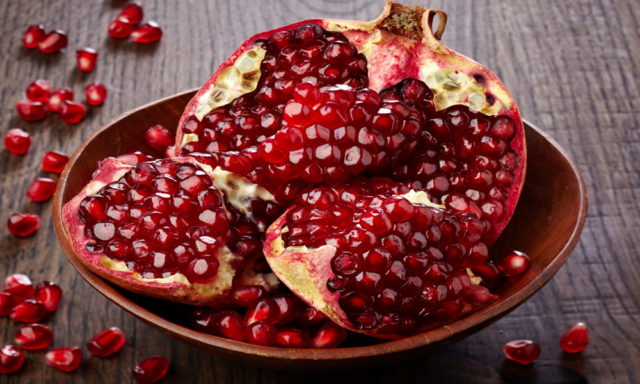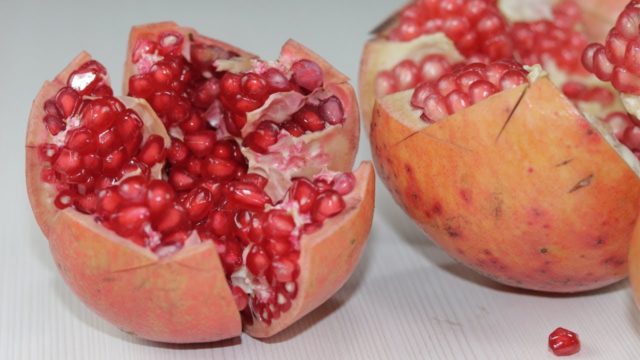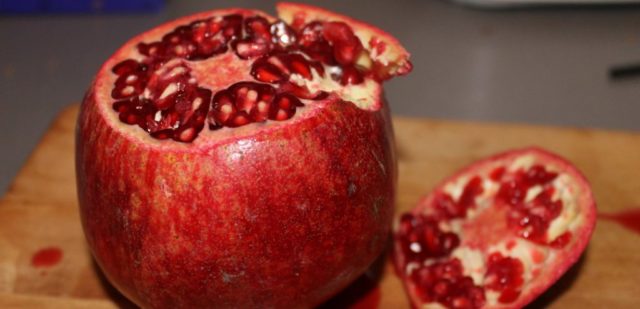Content
Choosing a fully ripe pomegranate that has the perfect balance of juiciness and sweetness is not easy. Knowledgeable consumers are familiar with several tricks, based on long-term observations, that allow to visually determine the ripeness of a large southern berry. Skills of tactile experience also help to choose a vitamin purchase.
When can you buy pomegranates
The ripening time for pomegranates is in autumn. Already in the first months of the off-season, a new crop goes on sale. In November, December and January, fresh, juicy and fully ripe fruits are selected in the markets. Pomegranate is an export object for many countries. To buy a fresh product, before purchasing, you can study:
- where the fruits go to store shelves;
- what season is the harvest in a particular country.
Experts advise choosing high-quality ripe pomegranates, as in the photo above:
- in winter - grown up in Latin America;
- in the spring - imported from Turkey and Egypt;
- in summer - from Greece;
- in the fall - brought from the Caucasus and Central Asia.
How to choose the right ripe pomegranate
The granular berry splashing red sweet juice is not cheap. Therefore, it is better to familiarize yourself with its features in order to choose a ripe and high-quality pomegranate, and not stale or rotten.
How to determine the ripeness of a pomegranate by its appearance
When choosing a pomegranate, you should look closely at large specimens, in which the juicy shell of the grains is usually ripe and sweet, and the film between the slices is thin and transparent. The most common fruit in stores with peel of different shades of red - from pinkish to orange. The cover is also bright red or intensely burgundy. The maturity of the pomegranate is often determined by the color of the peel. There are some varieties of other colors:
- pinkish green;
- white;
- cream.
The flesh can also be only slightly pinkish. But such varieties rarely go on sale. Most often they are purchased in the areas where they are grown - in Turkey, Egypt, Iran, Spain. Trees with such pomegranates grow in the Crimea.
How to Pick a Good Pomegranate Smell
A useful tasty fruit, if it is not cut, and there are no cracks, does not smell. Therefore, choose the right pomegranate, which does not emit any aroma. If you hear any smell, the fruit may have been damaged in transit. Due to compression or a strong impact, the skin cracked, and rotting processes began inside. A foreign smell is also possible, which has been absorbed due to storage in unsuitable conditions.
How to choose a delicious pomegranate by hardness
When buying, they also use the tactile method. When choosing a pomegranate in a store, they determine how hard its rind is. Ideally, it is not even, but with bends, dry and dense, without cracks. It seems that the thin crust hardly holds back the grains poured with juice, and therefore it is slightly deformed. When squeezed lightly, rows of dense grains are felt. The crust is also strong and cannot be pry off with a fingernail. The soft area indicates putrefactive processes due to the blow.
Another feature of a ripe pomegranate is a pleasant, slightly perceptible roughness. The external roughness indicates that the fruits have accumulated enough sugars, and they were plucked at the time of full ripeness. Only a pomegranate that is fully ripe on the tree will have the maximum concentration of juiciness and sweetness.
Having chosen the fruit, you can easily jerk it. With good quality, the crust adheres tightly to the grains. The feeling of a solid object in the hand. Fruit that has been lying for a long time dry up, the pulp significantly loses its juiciness. The shell of the grains becomes sluggish, the taste deteriorates.
The next indicator of ripeness - the crown at the top is formed of dry triangular sepals of a brownish shade or corresponds to the main color of the entire rind. When choosing a quality product, you need to know that sepals should not be green inside or too woody. An important point - in ripe fruits, the sepals are open, turned outward.
How to determine the ripeness of a pomegranate by weight
The easiest way to choose a ripe pomegranate when buying, if you focus on its weight and size, 8-10 cm in diameter. As a rule, fruits are brought to the market, the weight of which is in the range of 400-700 g. It is quite possible that those fruits that were picked unripe have a smaller mass. Large pomegranates have fresh and juicy grains. Between two fruits of exactly the same volume, choose the one that weighs more. The mass indicates the juiciness of the pulp. A dried specimen, which has already lost some of the juice due to wilting, may also have less weight. Or vice versa, did not have time to ripen, to fill up.
Experienced consumers choose the heavier fruit as it tends to be tastier:
- the pulp is filled with juice;
- enough sugar substances have accumulated.
How to choose sweet pomegranate by sound
A quick wit will help you apply another method by which a good pomegranate is determined. It turns out that these grainy berries with a tart taste can resonate interestingly at the time of their absolute ripeness. It may not be possible to choose them in this way with a seller in the market. And on the layouts in supermarkets, the most curious shoppers train carefully. Lightly flicking a fingernail on the grenade, which was chosen according to the criteria of appearance, listen to the sound emitted by the fetus. Many sources claim that high-quality specimens that have reached the maximum sugar content and are filled with juice emit a special sonorous sound. It has been compared to the ringing produced by lightly hitting a metal object.
This resonance is due to the significant amount of juice formed in the pomegranate pulp. Dry or unripe fruits also resonate in response to tapping, but in a different way. Low-quality fruits with a whole crust emit a dull, barely discernible hum. Damaged skin prevents any sound from being received. Only experienced buyers choose the product in this way. It's best to try it out at home first.
There is also a somewhat radical method to select a quality copy by sound. If you try to squeeze a grenade in your fist, you can distinguish a faint crunch. It is also said to be a sufficient indicator of a fresh and ripe product.
How to identify a tainted pomegranate
When choosing fruits from the proposed ones, first of all, they rely on visual assessment. The color of the rind determines whether the pomegranate is ripe or not, and then resort to more sophisticated quality control methods. Signals for caution are:
- mechanical damage to the peel;
- spots of a different color, which stand out sharply on a uniform surface;
- dents and cracks in the crust.
If it is allowed to pick up a pomegranate, it must be examined from all sides, paying attention to:
- for the safety of the peel;
- the presence of a uniform color of the cover with overflows similar in tone;
- the hardness of the fruit;
- dry sepals and their brown color;
- lack of smell.
Pomegranates with soft patches are laid aside without hesitation, because this is a clear sign of a spoiled product. Moreover, not only one slice can be of poor quality, but also all neighboring ones. The defect occurs from impact, freezing or infection with various rot pathogens. They categorically do not choose to buy pomegranates, in which a small black speck is visible on the soft area of the cover. Such a stain is an obvious sign of a focus of rot, from where the process has spread, most likely, to all slices.
Avoid buying fruits, choosing pomegranates according to ripeness, with a glossy skin, without roughness, which indicates their immaturity. Cracked specimens are dangerous in that fermentation often develops in them under the influence of air. As a result, fungi have already spread on the surface of the shells of the grains.
When choosing a pomegranate, it is also clear to the touch which fruits have been stored for a long time. In such specimens, the crust is too dry, thin, and voids are noticeable near it.
Conclusion
Choosing a pomegranate, ripe and sweet, means developing observation based on the recommendations received. Applying the advice of connoisseurs, choosing a pomegranate, they enjoy healthy and tasty fruits.











